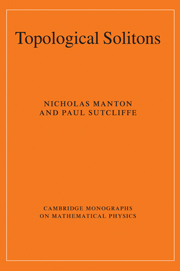1 - Introduction
Published online by Cambridge University Press: 12 January 2010
Summary
Solitons as particles
In the 1960s and early 1970s a novel approach to quantum field theory developed and became popular. Physicists and mathematicians began to seriously study the classical field equations in their fully nonlinear form, and to interpret some of the solutions as candidates for particles of the theory. These particles had not been recognized before - they are different from the elementary particles that arise from the quantization of the wave-like excitations of the fields. Their properties are largely determined by the classical equations, although a systematic treatment of quantum corrections is possible.
A characteristic feature of the new, particle-like solutions is their topological structure, which differs from the vacuum. If one supposes that quantum excitations about the vacuum are associated with smooth deformations of the field, then such excitations do not change the topology. So the usual elementary particles of quantum field theory, e.g. the photon, have no topological structure. The new particles owe their stability to their topological distinctiveness. Although they are often of large energy, they can not simply decay into a number of elementary particles.
In many cases, the topological character of the field is captured by a single integer N, called the topological charge. This is usually a topological degree, or generalized winding number of the field. The topological charge N can be identified as the net number of the new type of particle, with the energy increasing as |N| increases.
- Type
- Chapter
- Information
- Topological Solitons , pp. 1 - 14Publisher: Cambridge University PressPrint publication year: 2004



